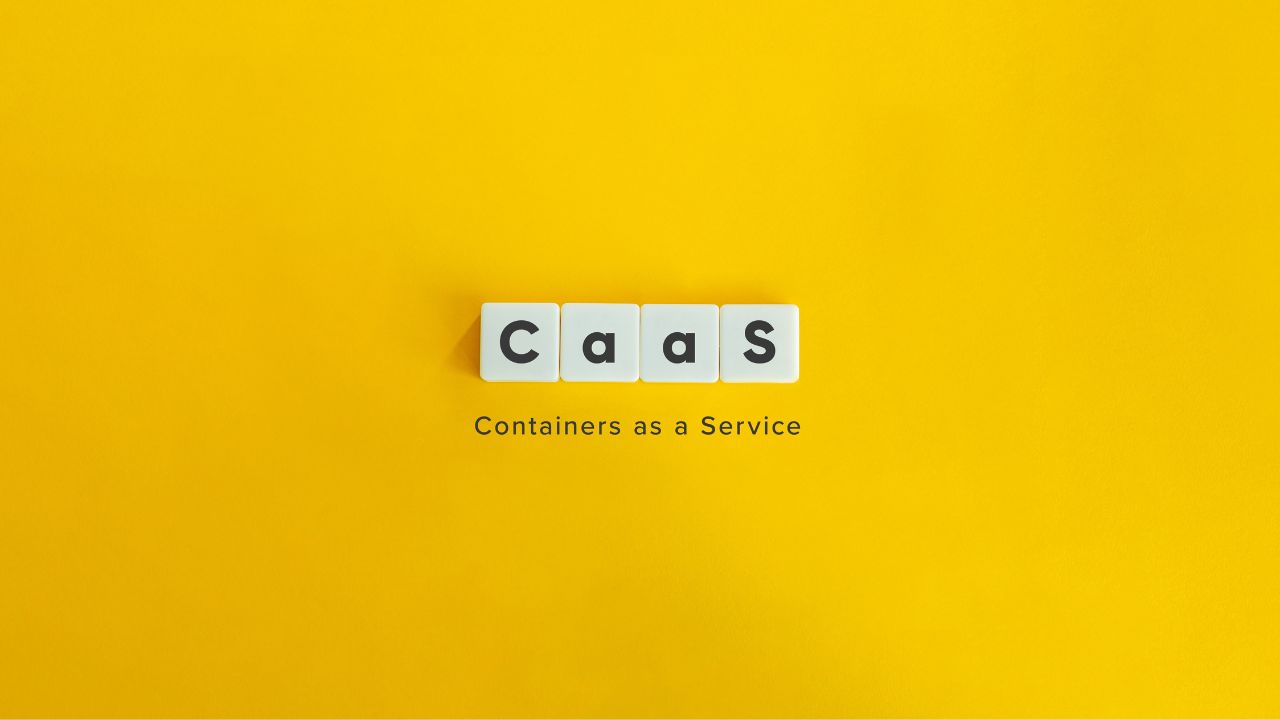
Managing containerized applications can be a nightmare. Not only does it take up huge amounts of resources, but it's also incredibly time-consuming, taking up hours and hours development team's time.
When applications aren’t managed correctly, however, your end users take the hit. From increase downtime, to app crashes and security issues, badly managed applications are bad news for your customers, leading to bad retention rates and ultimately a drop in revenue.
That's why many organisations are turning to cloud-based solutions like Container as a Service (CaaS) to simplify and streamline their application management processes.
This article delves deep into the meaning of Container as a Service (CaaS), exploring how CaaS solutions work, their benefits, and when they're suitable for your business.
What is Container as a Service (CaaS)?
Container as a Service (CaaS) is a cloud-based platform that simplifies the deployment, management, and scaling of containerized applications. These platforms provide a managed infrastructure for running containers, eliminating the need for organisations to manage and maintain their container orchestration tools and infrastructure.
CaaS solution providers offer a platform that abstracts away the complexities of managing containerized applications, allowing developers to focus on writing and deploying code.
They take care of tasks such as:
- Provisioning and managing containerized applications by providing a self-service portal for developers to upload their container images and deploy them to the cloud.
- Automatically Scaling containerized applications up or down based on demand.
- Managing the containerized application lifecycle including creation, updates, and removal.
CaaS allows developers to focus on their core business logic without worrying about the underlying infrastructure. CaaS is a popular choice for deploying microservices architectures, as it allows developers to easily scale and manage individual services.
How does CaaS work?
CaaS solutions work by providing a cloud-based platform that removes the complexities of managing containerized applications to save time for your developers.
This means developers can focus on writing and deploying code, while the provider takes care of the underlying infrastructure and operations.
With CaaS, developers upload their container images to the provider's registry and then developers deploy their applications using a self-service portal or API. The provider then provisions the necessary infrastructure resources, such as computing, storage, and networking, and deploys the container images to these resources.
CaaS providers typically use container orchestration tools like Kubernetes or Docker Swarm to manage the lifecycle of containers. These tools handle tasks like scheduling containers onto available nodes, load balancing traffic, and automatically scaling up or down based on demand.
The provider also provides tools and dashboards for monitoring and managing the deployed applications. This means developers can view health metrics, logs, and resource usage, and they can also perform actions like rolling out updates or performing diagnostics.
Containerized applications deployed on CaaS can be easily migrated to other cloud platforms or on-premises infrastructure, ensuring portability and flexibility.
What are the Benefits of CaaS?

CaaS is an attractive choice for organizations looking to deploy and manage containerized applications. It offers several benefits that make it a suitable choice for organizations looking to modernize their application delivery and infrastructure management strategies.
The benefits of CaaS can be broadly categorized into three main areas – ease of use and productivity, scalability and agility, and cost-effectiveness.
1. Ease of Use and Developer Productivity:
- Simplified Deployment. Providers handle the complexities of provisioning and managing container infrastructure, allowing developers to focus on writing and deploying code.
- Rapid Application Deployment. CaaS streamlines the deployment process, enabling developers to push code changes and have applications up and running quickly, reducing time to market.
- Improved Developer Workflow. It also simplifies the developer workflow, allowing for faster iteration and continuous deployment cycles.
2. Scalability and Agility:
- Automated Scaling. CaaS automatically scales applications up or down based on demand, ensuring optimal resource utilization and handling traffic spikes effectively.
- Flexible Deployment Options. CaaS supports various deployment models, including monolithic applications, microservices architectures, and hybrid cloud deployments.
- Agile Development and Releases. CaaS makes development and release cycles a breeze, enabling rapid adaptation to changing business requirements.
3. Cost-Effectiveness and Resource Optimization:
- Pay-as-you-go Pricing. Providers typically offer pay-as-you-go pricing, so organizations only pay for the resources they consume, reducing upfront costs and optimizing resource utilization.
- Reduced Infrastructure Overhead. CaaS eliminates the need for on-premises hardware infrastructure, reducing capital expenditures and operational costs.
- Efficient Resource Management. CaaS optimizes resource usage through intelligent scheduling and load balancing mechanisms, minimizing idle capacity and maximizing resource utilization.
- Simplified Infrastructure Management. CaaS simplifies infrastructure management, allowing organizations to focus on applications rather than managing servers and network configurations.
- Cost Savings through Microservices Architecture. CaaS supports microservices architectures, which are inherently more scalable and cost-efficient than monolithic applications.
When should you choose CaaS?
Container as a Service (CaaS) is a valuable option for organizations that want to deploy and manage containerized applications in a scalable and cost-effective way. But it’s not for everyone.
Here are some specific scenarios where CaaS is particularly well-suited:
- Streamlining Containerized Application Development and Deployment. If your organization is adopting containerization for application development, CaaS can streamline the deployment process and reduce the time to market for new features and updates. It automates infrastructure provisioning, container management, and scaling, allowing developers to focus on writing code rather than managing infrastructure.
- Handling Unpredictable Traffic Demands. If your applications experience fluctuating traffic patterns, CaaS's automated scaling capabilities ensure that your applications have the necessary resources to handle spikes in demand without compromising performance or incurring unnecessary costs. This is particularly beneficial for e-commerce platforms, content delivery networks, and other applications with unpredictable usage patterns.
- Microservices Architecture Implementation. CaaS is a natural fit for microservices architectures, which are becoming increasingly popular for modern applications. Microservices break down applications into smaller, independent services, each running in its own container. CaaS provides the flexibility and scalability to manage these microservices effectively, enabling efficient communication and fault isolation.
- Rapid Innovation and Continuous Delivery. If your organization prioritizes rapid innovation and continuous delivery of new features and updates, CaaS can help you accelerate your software development lifecycle. It streamlines deployment processes, integrates seamlessly with CI/CD pipelines, and provides centralized monitoring and logging, enabling you to deliver applications faster and with higher quality.
- Simplified Infrastructure Management. If you want to reduce the complexity of managing your IT infrastructure and minimize operational costs, CaaS can be a valuable solution. It eliminates the need for provisioning and managing physical servers, networks, and container orchestration tools. You only pay for the resources you consume, ensuring cost-effectiveness and optimizing resource utilization.
Challenges and Considerations of CaaS
While it offers several benefits, there are also some challenges that organizations should be aware of before adopting this approach.
Some of the Challenges you need to consider when choosing CaaS include:
- Vendor Lock-in. Providers typically lock customers into their specific platform, making it challenging to switch to another provider without incurring significant costs or rework.
- Too much complexity. While CaaS simplifies the management of basic containerized applications, it can become more complex when managing large-scale, distributed applications with multiple microservices and dependencies. This requires careful planning, orchestration, and monitoring to ensure the application's stability and performance.
- Security Concerns. CaaS environments can be more vulnerable to security breaches due to the potential for misconfigurations, container escapes, and insecure network communication between containers. Organizations need robust security measures, such as vulnerability scanning, intrusion detection, and access controls, to protect their containerized applications.
- Data Management challenges. CaaS environments often rely on ephemeral storage, which means that data stored in containers is not persistent and will be lost when the containers are terminated. Organizations need to implement data management strategies, such as using persistent storage volumes or databases, to ensure data durability and accessibility.
- Cost. While CaaS typically uses pay-as-you-go pricing, you'll need to carefully monitor resource consumption to avoid overprovisioning and unnecessary costs.
- Integrating with Existing Infrastructure. Organizations with existing infrastructure, such as on-premises data centres, may need to consider hybrid or multi-cloud deployment strategies to integrate CaaS with their existing environment effectively. This requires careful planning and integration efforts.
- Ongoing Monitoring and Observability. CaaS environments require continuous monitoring and observability to ensure the health, performance, and security of containerized applications. This involves using monitoring tools, logs, and dashboards to identify and troubleshoot issues promptly.
Final thoughts
CaaS offers several advantages for managing containerized applications, but you’ll need to carefully evaluate the potential challenges and considerations before adopting a CaaS Model.
Still. by addressing these factors, organizations can ensure that CaaS deployments are successful, secure, and cost-effective.











